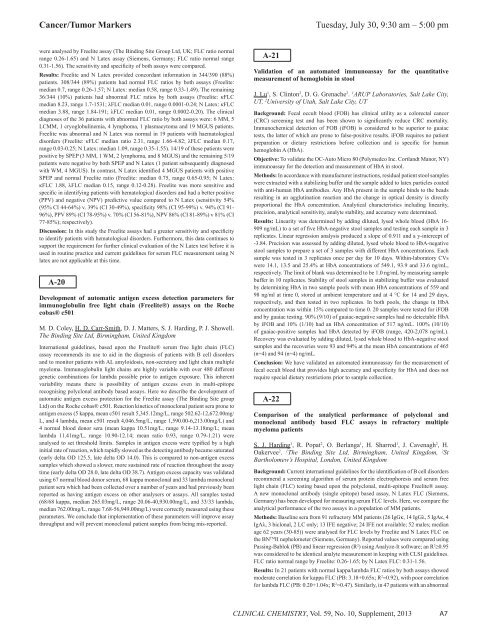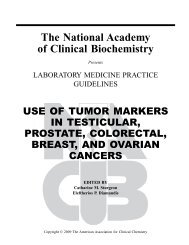Abstracts of the Scientific Posters, 2013 AACC Annual Meeting ...
Abstracts of the Scientific Posters, 2013 AACC Annual Meeting ...
Abstracts of the Scientific Posters, 2013 AACC Annual Meeting ...
You also want an ePaper? Increase the reach of your titles
YUMPU automatically turns print PDFs into web optimized ePapers that Google loves.
Cancer/Tumor Markers<br />
Tuesday, July 30, 9:30 am – 5:00 pm<br />
were analysed by Freelite assay (The Binding Site Group Ltd, UK; FLC ratio normal<br />
range 0.26-1.65) and N Latex assay (Siemens, Germany; FLC ratio normal range<br />
0.31-1.56). The sensitivity and specificity <strong>of</strong> both assays were compared.<br />
Results: Freelite and N Latex provided concordant information in 344/390 (88%)<br />
patients. 308/344 (89%) patients had normal FLC ratios by both assays (Freelite:<br />
median 0.7, range 0.26-1.57; N Latex: median 0.58, range 0.33-1.49). The remaining<br />
36/344 (10%) patients had abnormal FLC ratios by both assays (Freelite: κFLC<br />
median 8.23, range 1.7-1531; λFLC median 0.01, range 0.0001-0.24; N Latex: κFLC<br />
median 3.88, range 1.84-191; λFLC median 0.01, range 0.0002-0.20). The clinical<br />
diagnoses <strong>of</strong> <strong>the</strong> 36 patients with abnormal FLC ratio by both assays were: 6 MM, 5<br />
LCMM, 1 cryoglobulinemia, 4 lymphoma, 1 plasmacytoma and 19 MGUS patients.<br />
Freelite was abnormal and N Latex was normal in 19 patients with haematological<br />
disorders (Freelite: κFLC median ratio 2.31, range 1.66-4.82; λFLC median 0.17,<br />
range 0.03-0.25; N Latex: median 1.09, range 0.35-1.55). 14/19 <strong>of</strong> <strong>the</strong>se patients were<br />
positive by SPEP (3 MM, 1 WM, 2 lymphoma, and 8 MGUS) and <strong>the</strong> remaining 5/19<br />
patients were negative by both SPEP and N Latex (1 patient subsequently diagnosed<br />
with WM, 4 MGUS). In contrast, N Latex identified 4 MGUS patients with positive<br />
SPEP and normal Freelite ratio (Freelite: median 0.75, range 0.65-0.95; N Latex:<br />
κFLC 1.88, λFLC median 0.15, range 0.12-0.28). Freelite was more sensitive and<br />
specific in identifying patients with hematological disorders and had a better positive<br />
(PPV) and negative (NPV) predictive value compared to N Latex (sensitivity 54%<br />
(95% CI 44-64%) v. 39% (CI 30-49%), specificity 98% (CI 95-99%) v. 94% (CI 91-<br />
96%), PPV 89% (CI 78-95%) v. 70% (CI 56-81%), NPV 86% (CI 81-89%) v 81% (CI<br />
77-85%); respectively).<br />
Discussion: In this study <strong>the</strong> Freelite assays had a greater sensitivity and specificity<br />
to identify patients with hematological disorders. Fur<strong>the</strong>rmore, this data continues to<br />
support <strong>the</strong> requirement for fur<strong>the</strong>r clinical evaluation <strong>of</strong> <strong>the</strong> N Latex test before it is<br />
used in routine practice and current guidelines for serum FLC measurement using N<br />
latex are not applicable at this time.<br />
A-20<br />
Development <strong>of</strong> automatic antigen excess detection parameters for<br />
immunoglobulin free light chain (Freelite®) assays on <strong>the</strong> Roche<br />
cobas® c501<br />
M. D. Coley, H. D. Carr-Smith, D. J. Matters, S. J. Harding, P. J. Showell.<br />
The Binding Site Ltd, Birmingham, United Kingdom<br />
International guidelines, based upon <strong>the</strong> Freelite® serum free light chain (FLC)<br />
assay recommends its use to aid in <strong>the</strong> diagnosis <strong>of</strong> patients with B cell disorders<br />
and to monitor patients with AL amyloidosis, non-secretory and light chain multiple<br />
myeloma. Immunoglobulin light chains are highly variable with over 480 different<br />
genetic combinations for lambda possible prior to antigen exposure. This inherent<br />
variability means <strong>the</strong>re is possibility <strong>of</strong> antigen excess even in multi-epitope<br />
recognising polyclonal antibody based assays. Here we describe <strong>the</strong> development <strong>of</strong><br />
automatic antigen excess protection for <strong>the</strong> Freelite assay (The Binding Site group<br />
Ltd) on <strong>the</strong> Roche cobas® c501. Reaction kinetics <strong>of</strong> monoclonal patient sera prone to<br />
antigen excess (5 kappa, mean c501 result 5,345.12mg/L, range 502.62-12,672.00mg/<br />
L, and 4 lambda, mean c501 result 4,046.5mg/L, range 1,590.00-6,213.00mg/L) and<br />
4 normal blood donor sera (mean kappa 10.51mg/L, range 9.14-13.18mg/L; mean<br />
lambda 11.41mg/L, range 10.90-12.14; mean ratio 0.93, range 0.79-1.21) were<br />
analysed to set threshold limits. Samples in antigen excess were typified by a high<br />
initial rate <strong>of</strong> reaction, which rapidly slowed as <strong>the</strong> detecting antibody became saturated<br />
(early delta OD 125.5, late delta OD 14.0). This is compared to non-antigen excess<br />
samples which showed a slower, more sustained rate <strong>of</strong> reaction throughout <strong>the</strong> assay<br />
time (early delta OD 28.0, late delta OD 38.7). Antigen excess capacity was validated<br />
using 67 normal blood donor serum, 68 kappa monoclonal and 33 lambda monoclonal<br />
patient sera which had been collected over a number <strong>of</strong> years and had previously been<br />
reported as having antigen excess on o<strong>the</strong>r analysers or assays. All samples tested<br />
(68/68 kappa, median 265.03mg/L, range 20.06-40,930.00mg/L, and 33/33 lambda,<br />
median 762.00mg/L, range 7.68-56,949.00mg/L) were correctly measured using <strong>the</strong>se<br />
parameters. We conclude that implementation <strong>of</strong> <strong>the</strong>se parameters will improve assay<br />
throughput and will prevent monoclonal patient samples from being mis-reported.<br />
A-21<br />
Validation <strong>of</strong> an automated immunoassay for <strong>the</strong> quantitative<br />
measurement <strong>of</strong> hemoglobin in stool<br />
J. Lu 1 , S. Clinton 2 , D. G. Grenache 2 . 1 ARUP Laboratories, Salt Lake City,<br />
UT, 2 University <strong>of</strong> Utah, Salt Lake City, UT<br />
Background: Fecal occult blood (FOB) has clinical utility as a colorectal cancer<br />
(CRC) screening test and has been shown to significantly reduce CRC mortality.<br />
Immunochemical detection <strong>of</strong> FOB (iFOB) is considered to be superior to guaiac<br />
tests, <strong>the</strong> latter <strong>of</strong> which are prone to false-positive results. iFOB requires no patient<br />
preparation or dietary restrictions before collection and is specific for human<br />
hemoglobin A (HbA).<br />
Objective: To validate <strong>the</strong> OC-Auto Micro 80 (Polymedco Inc. Cortlandt Manor, NY)<br />
immunoassay for <strong>the</strong> detection and measurement <strong>of</strong> HbA in stool.<br />
Methods: In accordance with manufacturer instructions, residual patient stool samples<br />
were extracted with a stabilizing buffer and <strong>the</strong> sample added to latex particles coated<br />
with anti-human HbA antibodies. Any HbA present in <strong>the</strong> sample binds to <strong>the</strong> beads<br />
resulting in an agglutination reaction and <strong>the</strong> change in optical density is directly<br />
proportional <strong>the</strong> HbA concentration. Analytical characteristics including linearity,<br />
precision, analytical sensitivity, analyte stability, and accuracy were determined.<br />
Results: Linearity was determined by adding diluted, lysed whole blood (HbA 16-<br />
909 ng/mL) to a set <strong>of</strong> five HbA-negative stool samples and testing each sample in 3<br />
replicates. Linear regression analysis produced a slope <strong>of</strong> 0.911 and a y-intercept <strong>of</strong><br />
-3.84. Precision was assessed by adding diluted, lysed whole blood to HbA-negative<br />
stool samples to prepare a set <strong>of</strong> 3 samples with different HbA concentrations. Each<br />
sample was tested in 3 replicates once per day for 10 days. Within-laboratory CVs<br />
were 14.1, 13.5 and 25.4% at HbA concentrations <strong>of</strong> 549.1, 93.9 and 33.6 ng/mL,<br />
respectively. The limit <strong>of</strong> blank was determined to be 1.0 ng/mL by measuring sample<br />
buffer in 10 replicates. Stability <strong>of</strong> stool samples in stabilizing buffer was evaluated<br />
by determining HbA in two sample pools with mean HbA concentrations <strong>of</strong> 559 and<br />
98 ng/ml at time 0, stored at ambient temperature and at 4 °C for 14 and 29 days,<br />
respectively, and <strong>the</strong>n tested in two replicates. In both pools, <strong>the</strong> change in HbA<br />
concentration was within 15% compared to time 0. 20 samples were tested for iFOB<br />
and by guaiac testing. 90% (9/10) <strong>of</strong> guaiac-negative samples had no detectable HbA<br />
by iFOB and 10% (1/10) had an HbA concentration <strong>of</strong> 517 ng/mL. 100% (10/10)<br />
<strong>of</strong> guaiac-positive samples had HbA detected by iFOB (range, 420-2,078 ng/mL).<br />
Recovery was evaluated by adding diluted, lysed whole blood to HbA-negative stool<br />
samples and <strong>the</strong> recoveries were 93 and 94% at <strong>the</strong> mean HbA concentrations <strong>of</strong> 465<br />
(n=4) and 94 (n=4) ng/mL.<br />
Conclusion: We have validated an automated immunoassay for <strong>the</strong> measurement <strong>of</strong><br />
fecal occult blood that provides high accuracy and specificity for HbA and does not<br />
require special dietary restrictions prior to sample collection.<br />
A-22<br />
Comparison <strong>of</strong> <strong>the</strong> analytical performance <strong>of</strong> polyclonal and<br />
monoclonal antibody based FLC assays in refractory multiple<br />
myeloma patients<br />
S. J. Harding 1 , R. Popat 2 , O. Berlanga 1 , H. Sharrod 1 , J. Cavenagh 2 , H.<br />
Oakervee 2 . 1 The Binding Site Ltd, Birmingham, United Kingdom, 2 St<br />
Bartholomew’s Hospital, London, United Kingdom<br />
Background: Current international guidelines for <strong>the</strong> identification <strong>of</strong> B cell disorders<br />
recommend a screening algorithm <strong>of</strong> serum protein electrophoresis and serum free<br />
light chain (FLC) testing based upon <strong>the</strong> polyclonal, multi-epitope Freelite® assay.<br />
A new monoclonal antibody (single epitope) based assay, N Latex FLC (Siemens,<br />
Germany) has been developed for measuring serum FLC levels. Here, we compare <strong>the</strong><br />
analytical performance <strong>of</strong> <strong>the</strong> two assays in a population <strong>of</strong> MM patients.<br />
Methods: Baseline sera from 91 refractory MM patients (26 IgGκ, 14 IgGλ, 5 IgAκ, 4<br />
IgAλ, 3 biclonal, 2 LC only; 13 IFE negative; 24 IFE not available; 52 males; median<br />
age 62 years (30-85)) were analysed for FLC levels by Freelite and N Latex FLC on<br />
<strong>the</strong> BN TM II nephelometer (Siemens, Germany). Reported values were compared using<br />
Passing-Bablok (PB) and linear regression (R 2 ) using Analyze-It s<strong>of</strong>tware; an R 2 ≥0.95<br />
was considered to be identical analyte measurement in keeping with CLSI guidelines.<br />
FLC ratio normal range by Freelite: 0.26-1.65; by N Latex FLC: 0.31-1.56.<br />
Results: In 21 patients with normal kappa/lambda FLC ratios by both assays showed<br />
moderate correlation for kappa FLC (PB: 3.18+0.65x; R 2 =0.92), with poor correlation<br />
for lambda FLC (PB: 0.20+1.04x; R 2 =0.47). Similarly, in 47 patients with an abnormal<br />
CLINICAL CHEMISTRY, Vol. 59, No. 10, Supplement, <strong>2013</strong><br />
A7
















